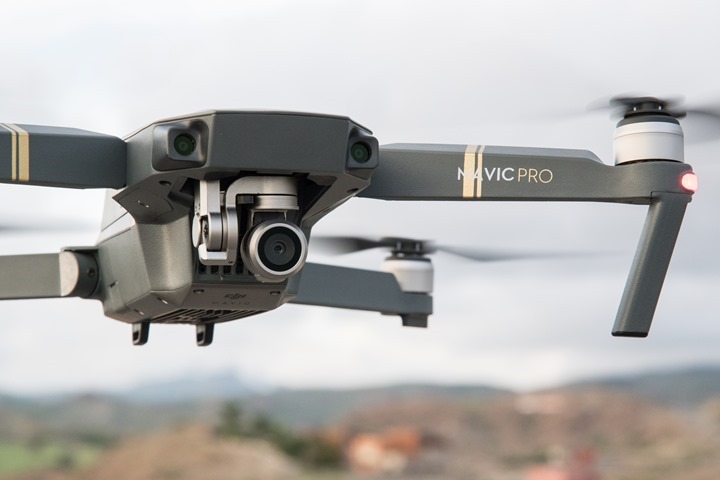Garmin Vivosmart 3 Activity Tracker In-Depth Review
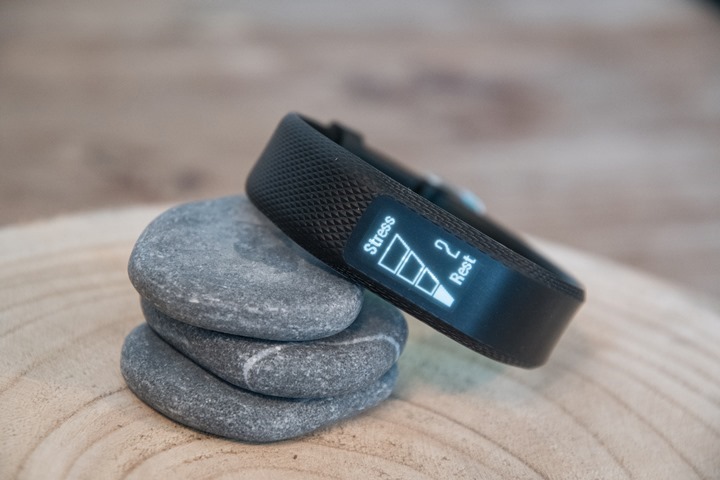
Today Garmin introduced an updated version of its Vivosmart lineup, the Vivosmart 3. This essentially takes the Vivosmart HR that we saw last year (aka Vivosmart Gen2) and shrinks it down. Then they layered in a bunch of new heart rate variability metrics to measure stress and VO2Max. At first glance it might be somewhat boring, but as I began using it more and more, I actually came away more impressed than I expected.
To be clear – this unit does not have GPS in it (like the Vivosmart HR+ does), rather, it’s the next in succession of mid-range priced activity trackers, meant to compete with the Fitbit Alta HR and Fitbit Charge 2. It also likely competes with a handful of other lesser known brands, but with Garmin and Fitbit going head to head in this market segment (sub-$150) for the majority of consumer dollars, these are the two most folks are looking at.
Finally, before we get into the review, this unit (actually, two units) are both media loaners. As always I’ll send them back to Garmin once I’m done (in fact, they’re already on the plane back to Garmin). I’ll then go out and get my own through regular retail channels.
So, let’s dig into it!
What’s new:
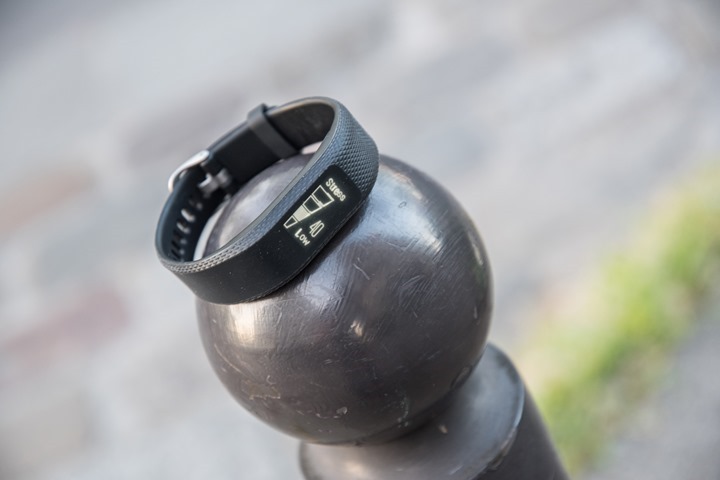
For those of you that are familiar with Garmin’s lineup of activity trackers, you’ll have a good baseline understanding of the basic functionality. So for this section I’m going to focus on what’s new/unique compared to the previous Vivosmart HR. As with almost all Garmin activity trackers, you’ve got the basics like smartphone notifications (of all types, not just text/call), activity/step tracking, music control, and exercise/workout monitoring. And you’ve got an optical heart rate (HR) sensor in there that works during both workouts and 24×7 monitoring. So, the normal stuff.
But here’s what’s new:
New 24×7 Stress Tracking Mode: This will score (1-100) and bucketize (low/med/high) your stress levels constantly (Update: This will come to the Fenix5 and FR935 via firmware update, no specific date is finalized yet)
VO2Max/Fitness Level Scoring: This will give you both a VO2Max value and a general score
New Relax/Breathing timer: This will walk you through breathing exercises to help you relax
Strength training mode: This can now count reps during certain activities
More constant 24×7 HR mode: This is akin to Fenix5/FR935 with far more frequent HR updates
Watch face choices: You can now select some (limited) watch faces
New Stop Watch/Countdown Timer: Pretty self-explanatory
Auto-start for Run/Walk Activity: Allows you to automatically trigger these workout types
Far thinner design: Reduced by 4mm compared to Vivosmart HR
Now, there is one new ‘features’ which can also be seen as downsides:
On-demand only display: This means the display automatically turns on when you raise your wrist, but is otherwise off to save battery time
So as you can see the new changes fit into two categories. First are some new software features, primarily aimed at 24×7 type functionality (Stress and better HR metrics). And then secondarily is a significantly reduced size in terms of the unit itself. It’s far smaller, that’s for sure. The previous unit was a bit clunky. Not bad compared to some options in the market, but the display ended up being kinda ‘hard’. Whereas this is a much ‘softer’ unit than previous.
Now I’m going to dive into all the new features in more detail throughout this post, but if you’re short on time (or prefer videos over text), then go forth and watch my overview here:
Okey doke, with the overview out of the way, let’s back up and unbox this puppy before diving into the details.
Unboxing:
The box design and contents of the Vivosmart 3 are pretty similar. The box itself isn’t much different in size than a can of soda (not one of those funky tall Redbull-style types though).
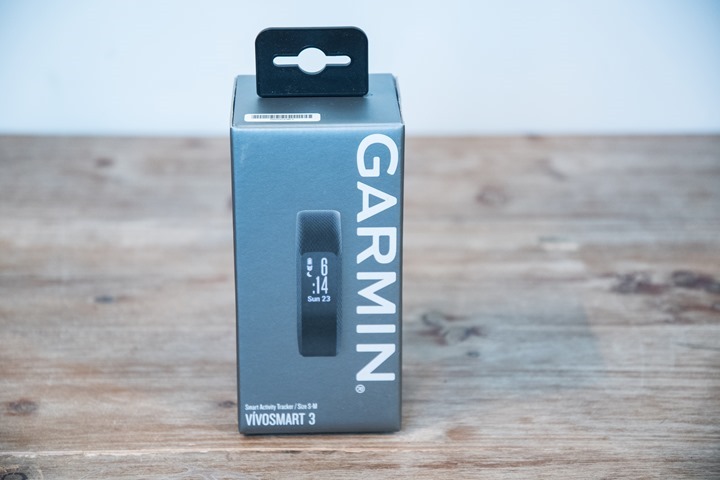
Inside you’ll find the unit, a charger, and some paper goodness, all protected in plastic or foam:
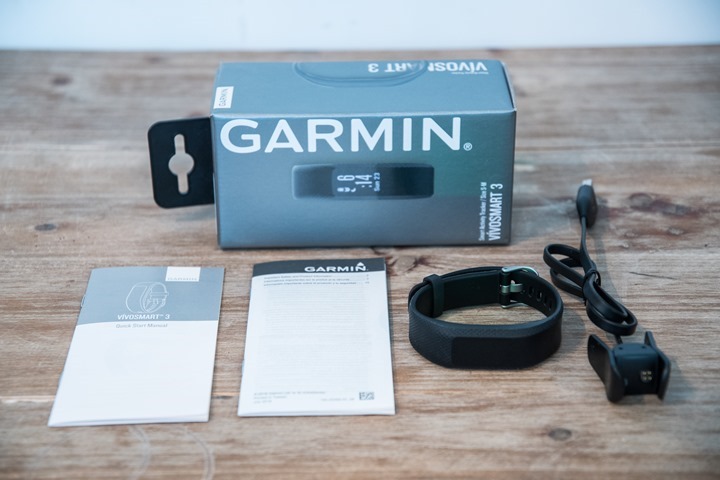
Note that there are two sizes available (small/medium, and large). And two colors (black and purple), though purple is only available in small/medium. If you’re a bigger wristed fella…purple is not in your future.
First up you’ve got the charging cable, which somewhat disappointingly isn’t the supposedly “new Garmin wearables standard” found on the Fenix 5 and FR935 series. That was somewhat the justification for creating the new charging/sync cable. So, in any event, here’s the other new variant:
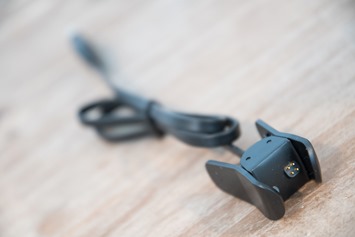
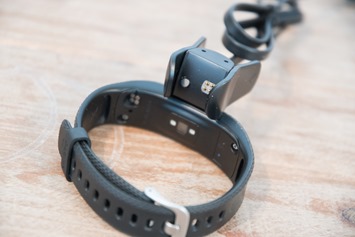
Then we’ve got some paper quick start guide and legal stuff:
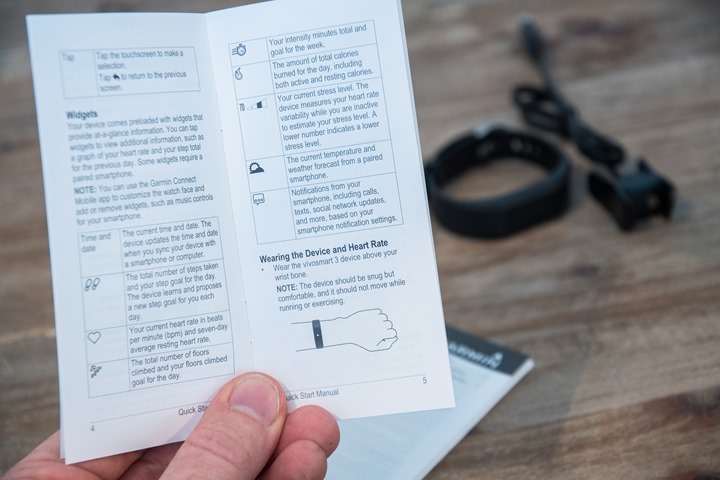
And then finally, the unit itself:
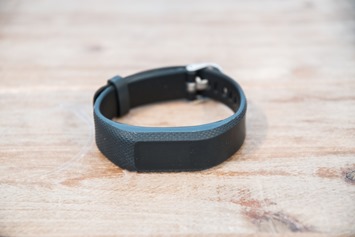
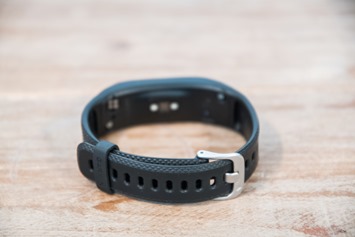
Note that the band is *not* swappable like the Fitbit Alta/Alta HR bands. Instead, it’s more like the Fitbit Charge/Charge HR band in that it’s as-is.
Finally, to compare it in weight to the Vivosmart HR (29g), versus the 21g of the Vivosmart 3.
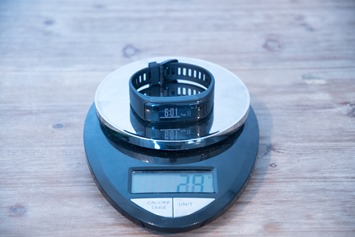
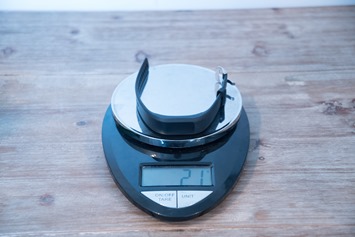
Oh and size too! Here it is next to the Vivosmart HR, to give some context on size differences:
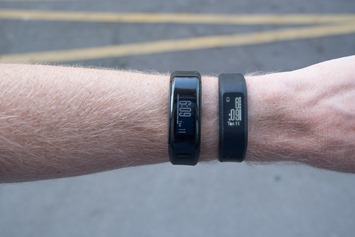
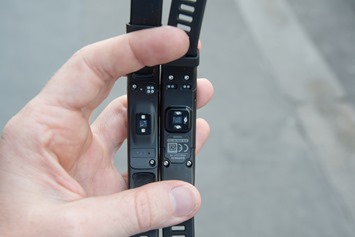
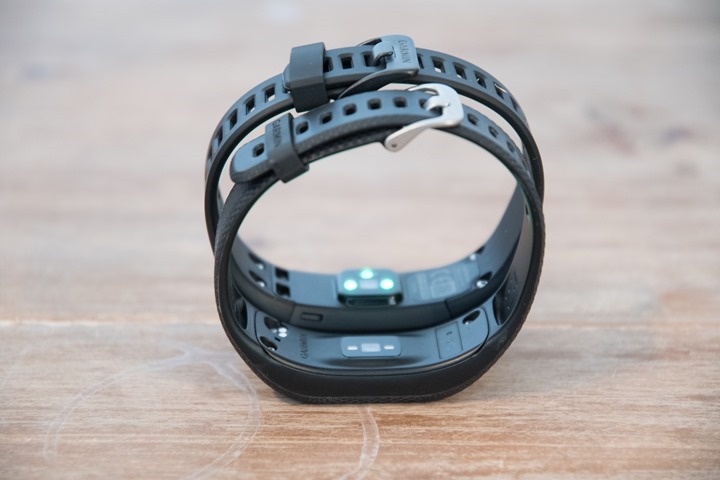
As you can see, it’s a pretty dramatic difference. In many ways it’s almost back to the size of the very first Vivosmart edition. You’ll also note just how much smaller/thinner that optical HR sensor is too.
The Basics:
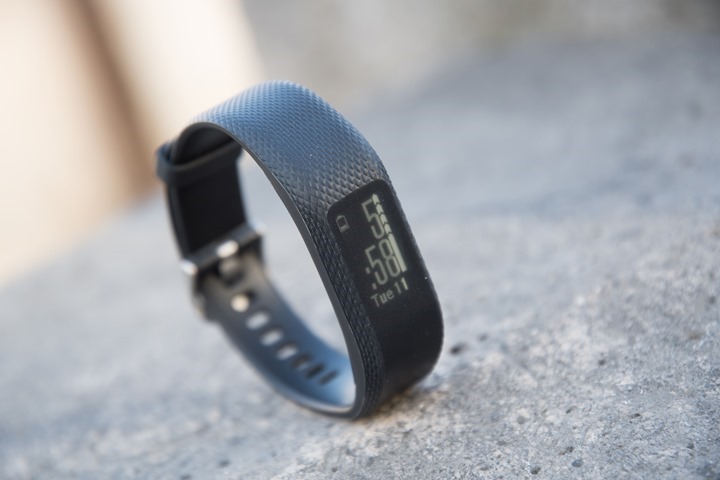
Of course at its core, the Vivosmart 3 is a typical Garmin activity tracker. By that I mean that it’s going to do all the basics like counting steps, distance, calories burned, and even flights of stairs (using its barometric altimeter). You can swipe through all of these metrics on the main screen.
(Preemptive important note: In some photos it may appear as though the display is split in half or otherwise funky. In real-life it doesn’t look like that. It’s merely a factor of the photo shutter speed not quite being perfect enough to capture it. Sometimes I got it nicely, other times I missed it. Again, to your eyes it always looks perfectly lit up.)
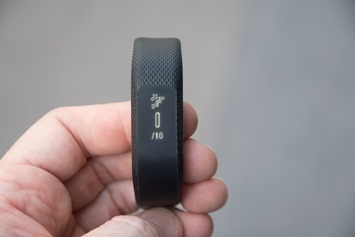
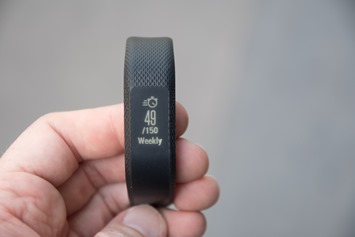
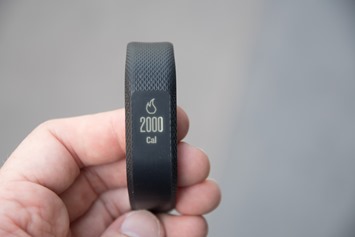
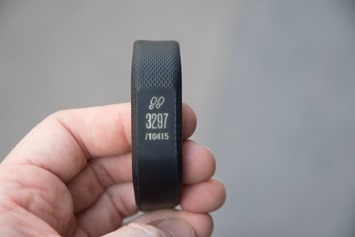
You can also dive further into any given metric by tapping it. For example, on the heart rate screen, it’ll show you your HR for the past hour. And on the distance screen, it’ll show you yesterday’s distance if tapped.
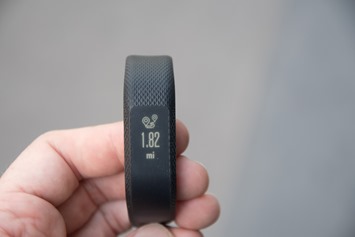
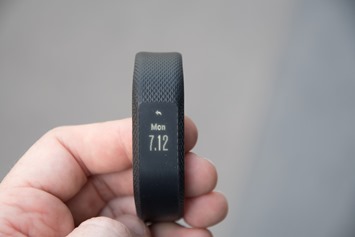
You can change the orientation of all these screens via the phone app, allowing you to go with vertical or horizontal.
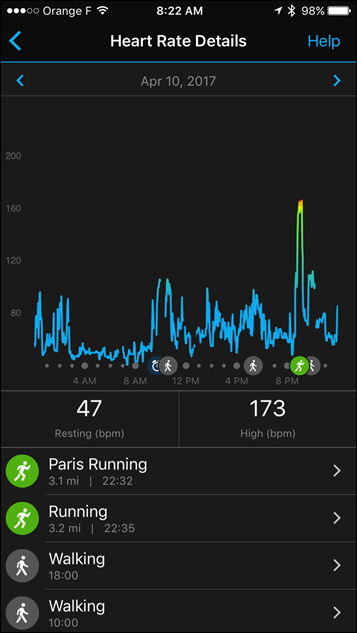
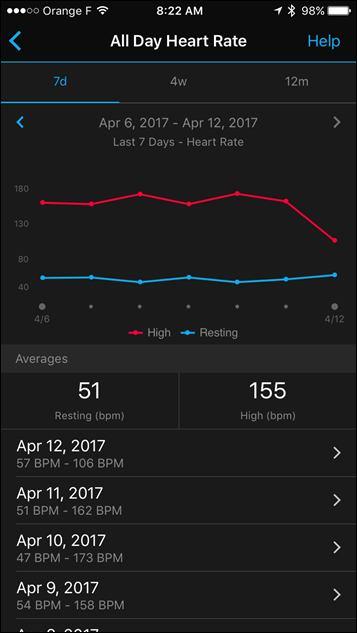
When looking at step-counter accuracy, things are in the ballpark of other devices worn on my wrist at the same time. For example, I was wearing a Suunto Spartan Sport Wrist HR, and those steps were pretty close to that of the Vivosmart 3.
Ultimately though – these devices should be used for you to look at trends. For example, if you’re at 9,900 steps out of 10,000 for a day, then just go walk around the block once. Meanwhile, if you’re at 2,000 steps for the day – then it was a lazy day. The unit isn’t likely going to be off by 8,000 steps. Make sense?
The flights of stairs metric works fairly well overall, though for whatever reason it can’t seem to track the set of stairs from the DCR Cave up to the DCR Studio, perhaps it’s too short or something, though it’s one full flight. All other stairs (such as within our apartment) track just fine. All of this is then also displayed within the app itself on both the dashboard page as well as then the details page for floors:
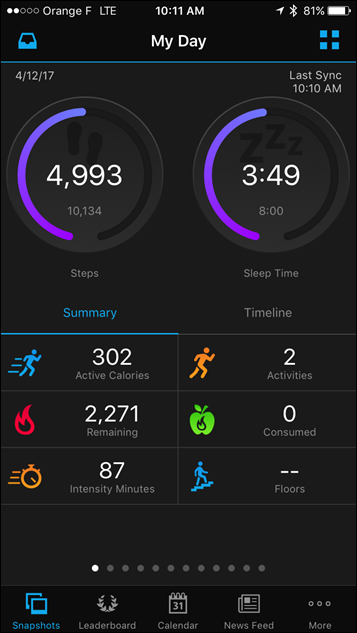
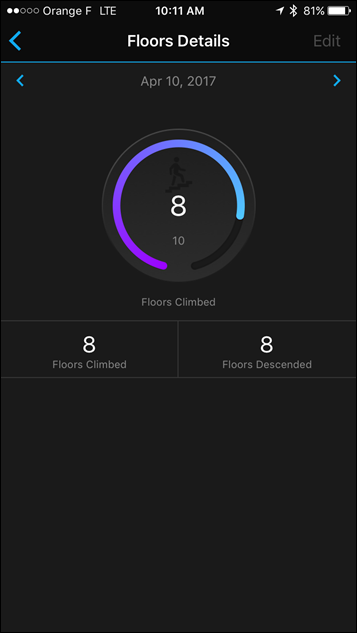
Like other trackers, it’ll track sleep as well. I’m continuing to find Garmin’s tracking of sleep across all its devices to be pretty solid for me (at least in terms of awake/sleep times). It usually nails those down to the minute.
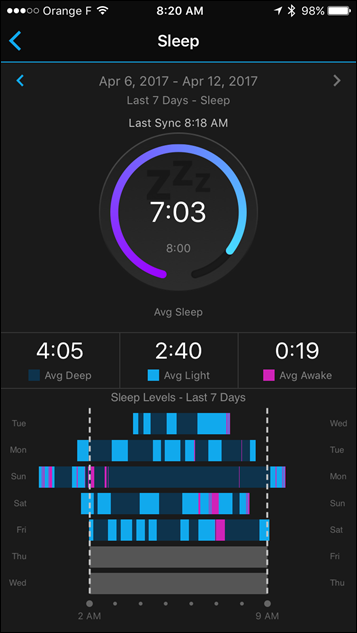
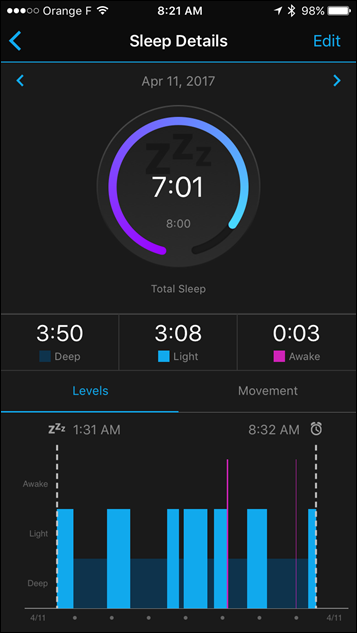
There’s nothing you need to do on the device itself, it’ll just figure it out automatically. After which you’ll see the above sleep charts for each night. Those are both on the site or the app. Your choice. Note that I can’t really speak to whether or not the different sleep states are accurate. Though I can generally say that where it identifies me as awake during those times, it’s usually spot-on (and usually because the baby is upset about something).
Where Garmin starts to differentiate itself from others is more of the deeper data beyond just steps/calories/distance. For example, the unit will monitor what they call ‘Intensity Minutes’, which is basically just times you got your heart rate up. Be it running for a bus, going out for a workout, or having fun in bed. Your choice.
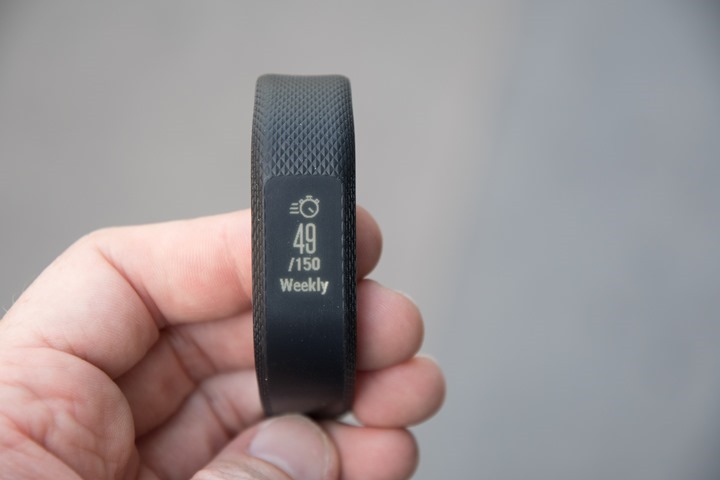
This is tracked against a goal for the week, which defaults to 150 minutes. This is based on the recommended number of ‘moderate exercise’ minutes per week being 5x30minutes, so 150 minutes.
Next, we get into the newest feature – stress tracking. Within this, the unit will utilize the optical HR sensor and heart rate variability to track your stress while not in a workout. It does this constantly, like every few seconds constantly. It’ll then give you a score between 0 and 100, as well as a general bucket (Low/Medium/High):
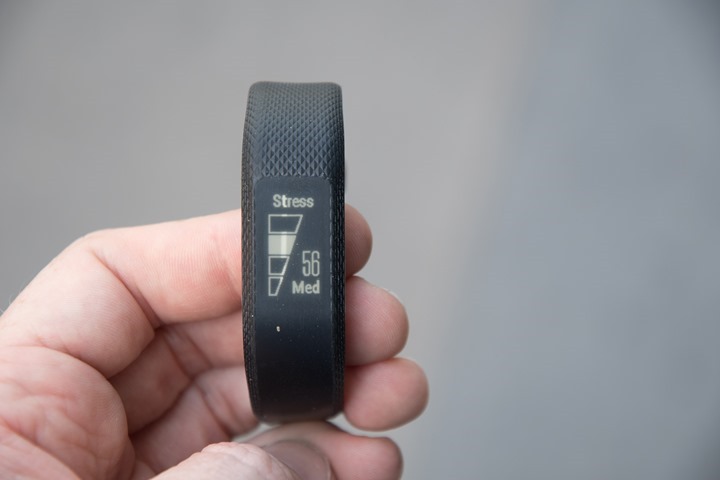
You can tap on the stress screen again to get trending for the last hour (the below photo has some gaps because I was taking photos during this time period):
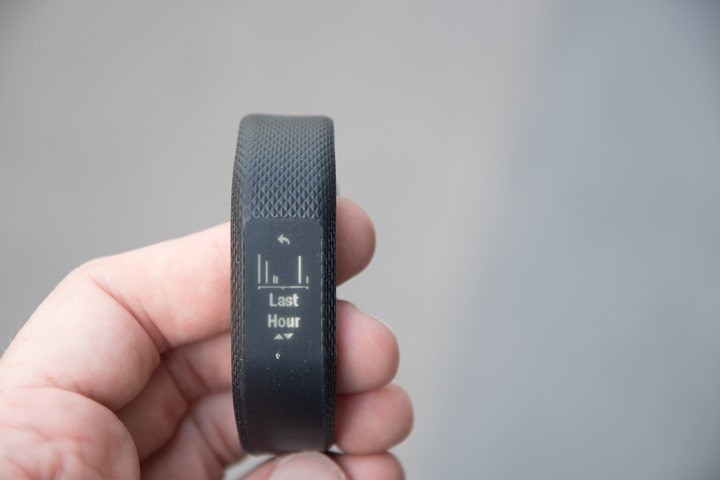
Alternatively, you can tap yet again to then do breathing exercises. But more on that in a second. In addition to showing stress on the device, you can see it on the mobile app and online.
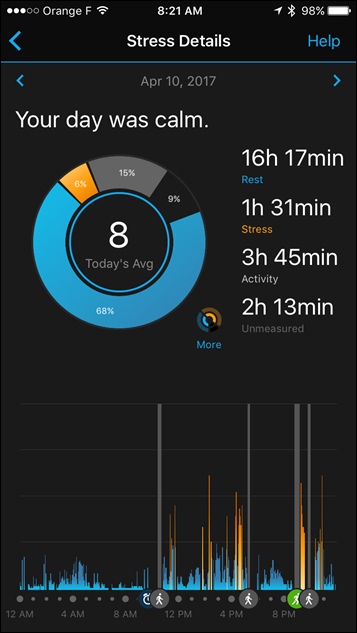
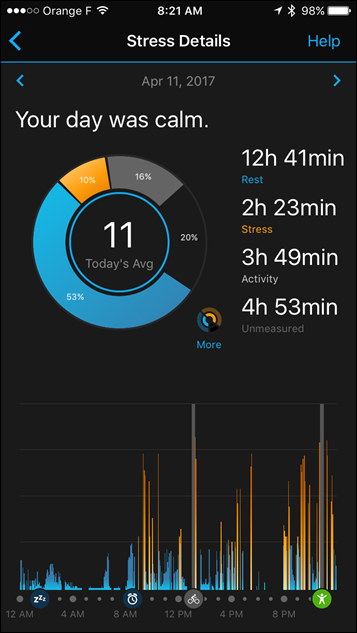
I’m actually more impressed with this than I would have thought. At first, it seemed gimmicky, but then I broke down one of my days and it pretty much nailed what I was feeling from a stress standpoint throughout the day. For example, in the below image, you can see my stress level is virtually non-existent during sleep. Then my workout in green in the morning (bike ride) for a few hours. Then following that I’m doing some odd errands.
However around 2:12PM things get super stressful. That’s us spend 45 minutes in traffic (ironically because of the Paris Marathon) trying to get a short 10-15 minutes away. Every street I went down was closed for non-marathon reasons. Kinda a mess. But, it’s interesting to see that.
You then see an automatically triggered walk around 4:30PM, which is us walking back instead of driving. That takes about 60-75 minutes. At around 6PM you see another high-stress moment, which was me trying to get some filming done with The Girl, and things not entirely going according to plan. After that the day is pretty routine. But what’s interesting is just how easy this is to align to the data.

Now Garmin’s solution to a stressful life is to take some deep breaths. So you can crack open a new relaxation/breathing exercises feature that walks you through taking in deep breaths, holding them, and then exhaling. You breathe in for four seconds, hold, and then breathe out for four seconds.
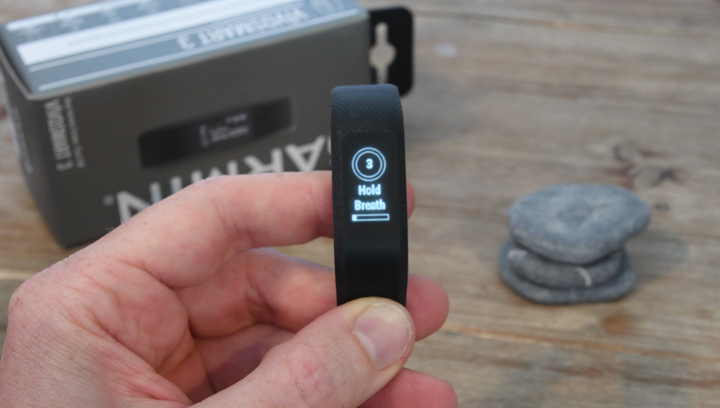
You can configure the duration of this stress relief scheme, though the default is two minutes.
The next new feature on the Vivosmart 3 is the VO2Max estimation. This falls in line with what Fitbit introduced last year, as well as what Garmin has had on their own wearables for some time. This is just the first time we’ve seen it on these less expensive non-GPS models.
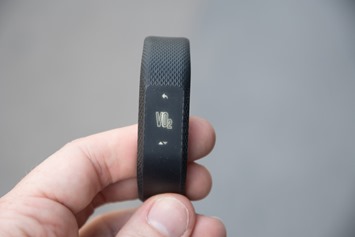
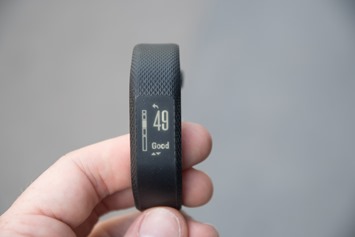
The VO2Max metric is tracked on the unit itself through your normal workouts. You can also do a 15 minute walking test to get data too. Like other devices using the VO2Max metrics, it’ll take at least a few workouts of good data to get more accurate. For example, on each run I do the number continues to climb (just like it did on the Fenix5 and FR935), and will likely continue to do so for a few weeks. The metric tends to stabilize after 2-3 weeks of normal workouts.

(Note: In the above screenshot you won’t get a Cycling VO2Max, since that’s from a different product. Just a general/running VO2Max value.)
Before we talk workouts, let’s wrap up the basics section with some general stuff. First, it has smartphone notifications like all other Garmin wearables these days. It does full notifications, meaning that they aren’t limited to just text/calls like some other bands. It’s whatever apps you have configured for notifications on your phone (iOS/Android/Windows).
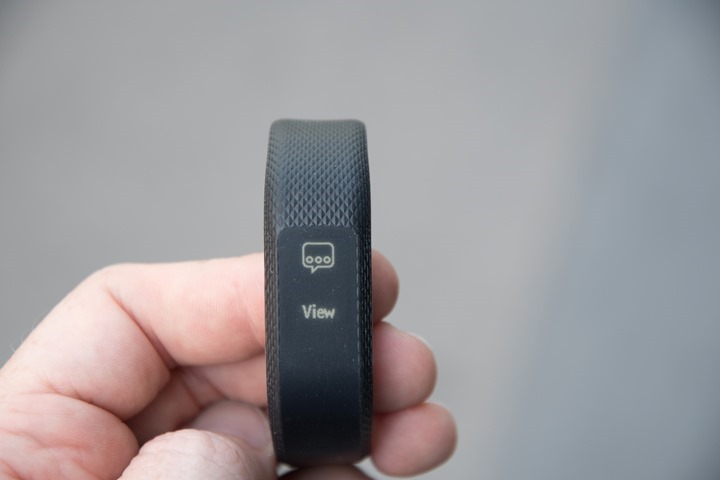
Next is that the display is no longer always-on. Rather, it’s on-demand. There are two options here to get the screen to turn on. First is gesture based, meaning you raise your wrist. That tends to work fine when you’re walking or some other stance that it’s a large arm-swing. But it doesn’t work as well while sitting at a table for example, or on a couch. I’ve raised my wrists plenty of times and nothing has happened.
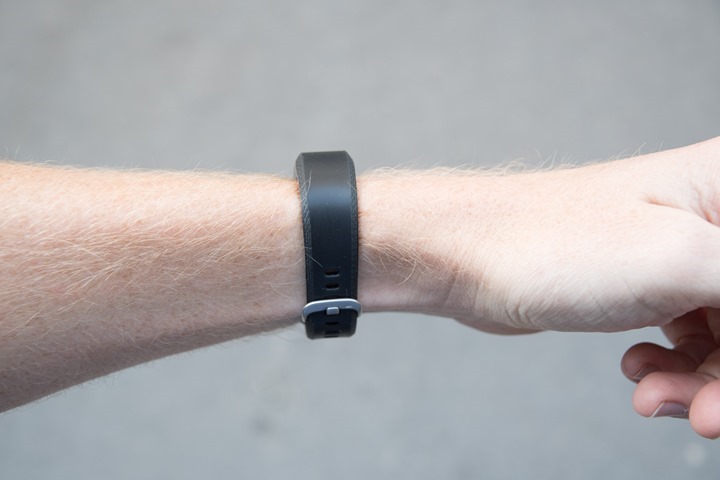
The second method is to double-tap the screen, which will also turn it on for a few seconds. After which it’ll go back off. That’s fine, but also somewhat annoying. I just wish it would stay on like the Vivosmart HR did.
On the bright side, the display’s backlight is a hell of a lot brighter than the Vivosmart HR was. Like the difference between stadium lighting and dungeon lighting difference. I can pretty much illuminate half the bedroom with it at night. Don’t worry if it’s too bright, you can adjust the brightness levels as you see fit.
Finally on the display front is watch faces. Garmin now gives you a handful of watch faces to select from. These aren’t from Connect IQ, but they do allow some basic customization:
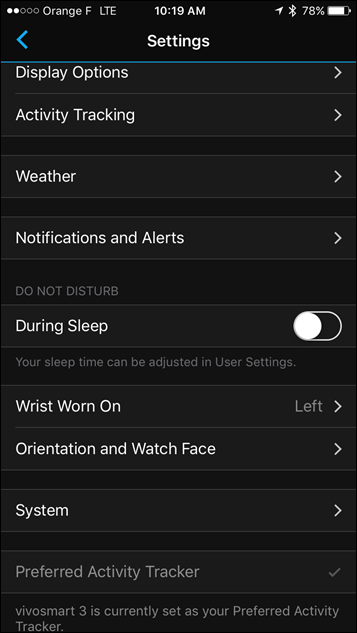
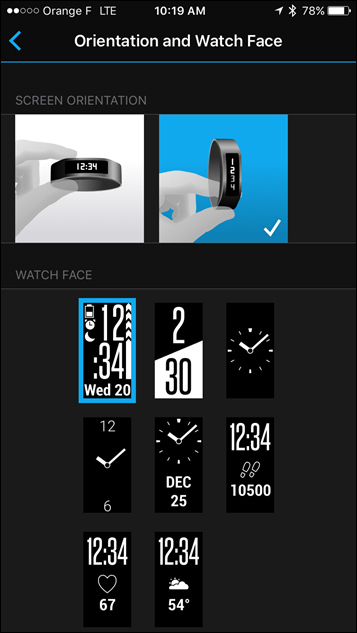
Now that we’ve covered all the non-workout pieces, let’s talk workouts.
Workout Modes:
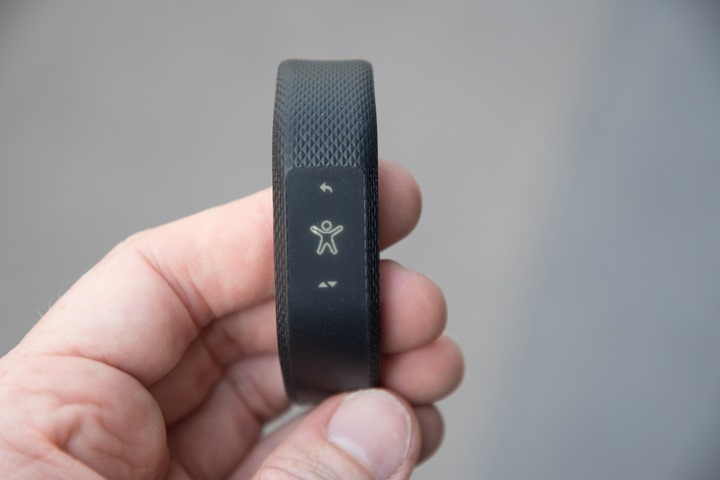
One of the biggest strengths of Garmin’s platform has always been the fitness side of things. The original Vivofit for example aimed to bridge that gap by being one of the first that allowed you to pair to an existing heart rate straps. Then the original Vivosmart even allowed cycling sensors.
These days the unit has an optical HR sensor within it, and did away with the cycling sensor support. But it still retains a handful of sport modes, which are:
– Walk
– Run
– Cardio
– Strength Training
– Other
Each sport mode can then subsequently be customized with custom data pages using a handful of data fields:
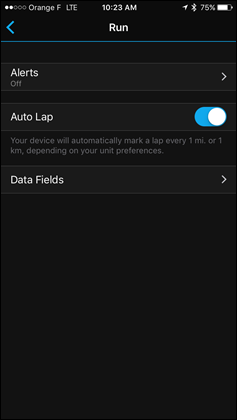
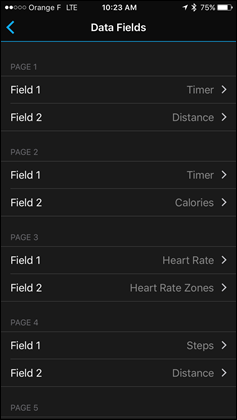
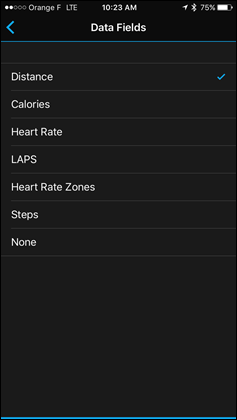
For example, in ‘Run’ mode, you can choose the following data fields: Timer, Distance, Calories, Heart Rate, Laps, Heart Rate Zones, Steps, or…well…none. Yes, none is a data field option. You can customize up to four pages, plus one date/time page. Some sports like strength training get less pages (two), though do gain the ‘Reps’ data field.
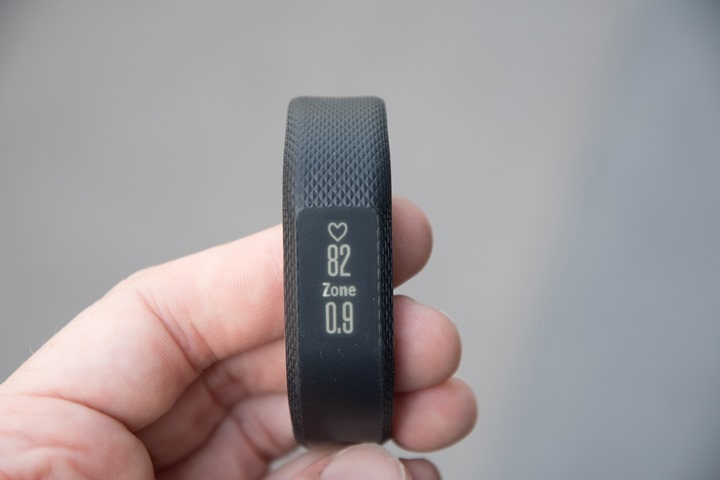
Note that pace is not an option. Garmin argues that since the device doesn’t have GPS (like the earlier Vivosmart HR), that it doesn’t need it. Also, it doesn’t connect to a footpod either.
Of course, it can still get distance just fine using the accelerometer internally. You can either use the defaults to let it determine stride length, or you can set a custom one.
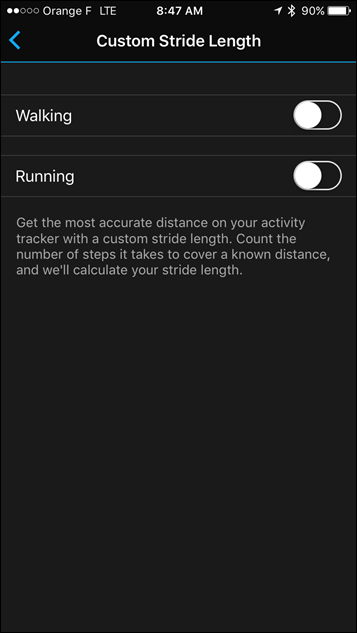
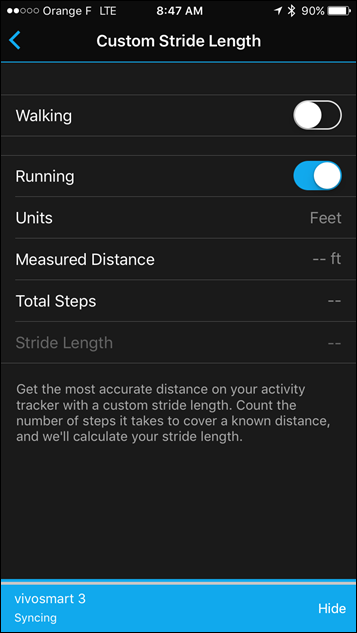
I was actually pretty impressed with how close it came on distance on a few activities. For example here’s a run from a two days ago where I varied the pace quite a bit:
Garmin FR935 GPS: 3.12mi
Garmin Fenix3 GPS: 3.18mi
Vivosmart 3: 3.20mi
I saw the same thing on another run, where I was pushing a stroller at the beginning so the initial distance was a bit wonky since my wrist was static. But once I went single-handed and let the wrist with the Vivosmart 3 roam free, it tracked really darn well for the remainder of the 10ish mile run.
You can also configure basic alerts as well within some of the different sport modes. Nothing fancy, but certainly useful for those that are aiming for a specific target.
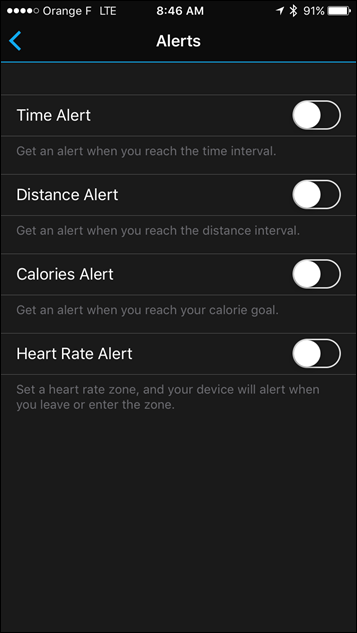
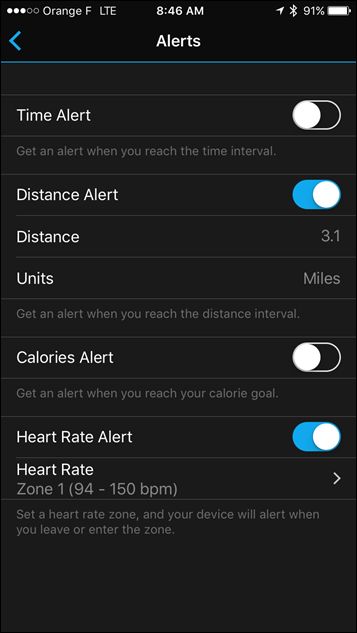
When it comes to the data you’ll get after a run (for example), it’s somewhat limited. You’ll see your heart rate throughout that activity, as well as pace. You can see that data below (or here on the actual activity file).
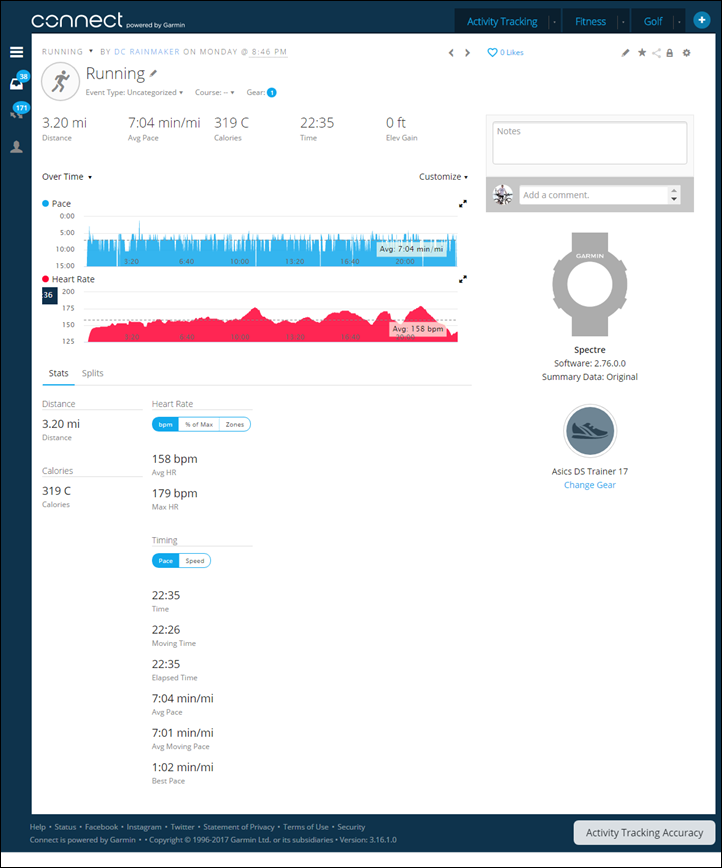
The newest feature though to the Vivosmart 3 is the ability to count reps, for strength training. This allows you to go into a mode where it’ll count anything your wrist is attached to (meaning, it won’t count leg press type stuff).
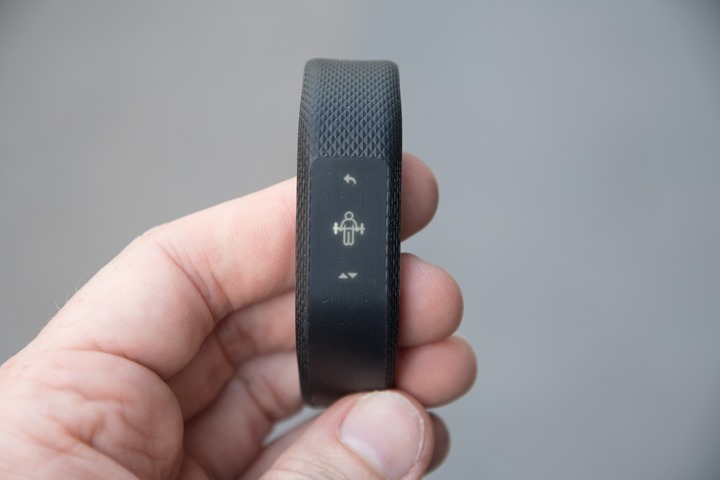
As part of that it has both a rest timer and a rep timer. So after each set you can press to continue into a rest section, where it’ll count upwards in seconds. Then swap back to reps. And on and on forever.
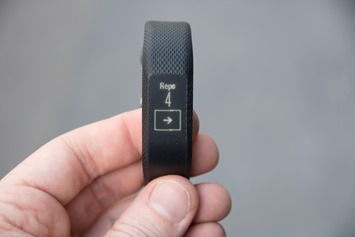
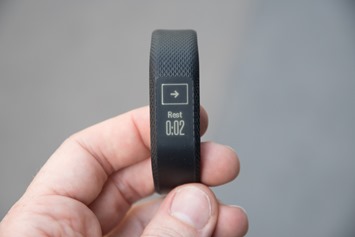
It works better than I expected. I found if I focused on consistency and form (which, is good guidance to begin with), it correctly counted all my reps. However, if I fell off the boat a bit there, it might miss one or two. It never over-counted, but rather if it made an error it would under-count. In fact, it’ll even categorize these after the fact – such as bench press, or tricep extension. Both of it which were correct (in spirit anyway, I didn’t have a bench handy – so I replicated said movement).

You can also then specify the weight used for each.

And as seen above, you can also add more exercises that may not have been captured (such as leg-focused items). And it’ll tally everything up at the end on the page.
It’s actually implemented much better than I would have expected in looking at the specs. I presumed it’d just give a timer and that’s it, but to see the data is kinda neat.
So overall for most folks it’ll get the basics right. The running distance accuracy for me (and my stride length) works out pretty well. The sport modes are kinda limited, so for example when I did a bike trainer ride there isn’t a bucket for spin/bike, so I just had to use the general cardio bucket. Everything somewhat ends up falling into that. Which is a bit different than Fitbit which gives you far more customization options than just a single bucket (over 20 sports at last count). Even if the internal algorithms are identical, the ability to correctly label those sports automatically in the app is preferred over manually changing them.
Heart Rate Accuracy:
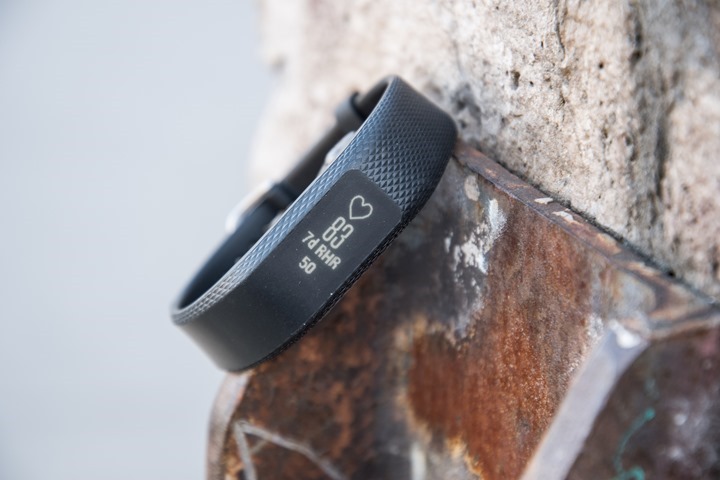
Of course, one of the biggest features of the unit is its optical heart rate sensor. That has two modes – one that’s used for 24×7 monitoring, and the other mode for workout monitoring. In general, I’ve found the 24×7 mode pretty solid. It matches what my heart rate is at, and sticks with it all day long. No real issues there (and no surprise, since that’s pretty easy).
The next piece is of more interest though, which is the workout tracking. That’s where things get a bit more challenging for optical sensors, especially ones on small bands like the Vivosmart 3. The smaller the band the more possibility of light getting in. When more external light gets in that makes it more difficult for optical HR sensors.
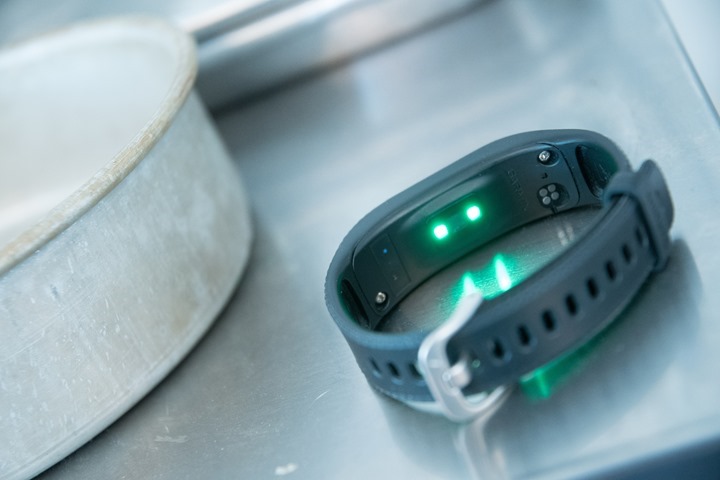
Still, despite the inherent limitations of the form factor I was curious how it’d handle in workouts. The first one we’ll dig into was a 10-mile (~15KM) run. In order to provide comparison data I had other HR sensors on me as well. First was a traditional chest strap, then the Scosche optical HR sensor armband, and then the Suunto Spartan Sport Wrist HR.
Now on this run I was pushing a stroller, but I was actually only using my right hand instead of both – thus leaving the left hand with the Vivosmart 3 free to swing as normal. The only exception was the first and last few minutes because I had to dodge a bunch of sun-soaking people out enjoying the day. In any case, here’s how that data looked:

So as expected, those first few moments were pretty wonky for the Vivosmart 3. Though the Suunto Spartan Wrist HR handled pushing the stroller without issue, it turned out to be quite the challenge for the Vivosmart 3’s optical sensor. But once I went back to normal arm-swing (one-handed push), it snapped right on for the rest of the run. As you can see, the chart looks really darn good.
In areas where I had some small hills, it also tracked pretty well there too – faster than the Spartan did, and nearly spot-on with the rest of the line. The Vivosmart 3 did seem to diverge a bit though when I briefly pushed with two hands. So…one-handed it will be from here on out!

Next, we’ve got a shorter run that I did as a bit of a test of responsiveness. In this case it’s only 5KM (data here), but I varied the intensity a bunch, as well as varied the ramp rates a bunch. The point being to find lag in the heart rate sensor. For this test I had a similar setup, though sans the Suunto Spartan Sport Wrist HR. So just three HR sensors in total:

Overall it’s pretty good. There’s a bit of a variance at the beginning where the Vivosmart 3 reads higher than the others. But I’m not convinced it was incorrect there. It’s really hard to know in that first 60 seconds when it comes to heart rate ramp. Both are believable tracks. After that though, all mostly agree.
What you see below is that the optical HR sensor generally lags a tiny bit (barely) in the recovery (as does the Scosche), but does catch up. And we’re only talking a few BPM and only a few seconds…below would be extreme nitpicking. This is somewhat common, and not nearly as bad as what I see in Fitbit’s sensors. So I’d actually give it better marks here. Better than I expected actually.

Next, let’s look at another area – outdoor cycling. For this I’ve got a few different rides, but we’ll just stick to this 90 minute or so ride to analyze since it’s easier to show. Plus, they all look roughly the same anyway. I had with me a similar setup in terms of extra HR strap and Scosche, as well as the Suunto Spartan Sport Wrist HR:

In case it’s not overwhelmingly obvious above (the yellow line): It sucked. Badly.
As it did again on my next outdoor ride. And, as is somewhat common for Garmin’s optical HR sensors outdoors, let alone the ones on smaller form factors like this. Don’t worry, Fitbit’s also suck for me while riding too.
For fun though, I took it indoors on a brief bike trainer test, this one with a bunch of power fluctuations. Thus, rapid changes in intensity in a significant way. Here’s how that turned out:

Well, that’s definitely a whole lot better. And it’s of no surprise. Most optical HR sensors tend to do well on indoor bikes/spin bikes/etc, because there are no vibrations from the roads. Thus eliminating one of the key challenges for optical HR sensors while outdoor cycling.
So where do we stand? Well, I’d say that for running it’s generally OK but with a bit of lag. So be aware of that if you need it to be super-responsive for intervals or such where you’re focused purely on HR intensity, then it may not be the right choice. Whereas for cycling outdoors it’s totally useless. Whereas cycling indoors is just fine. The challenge with the outdoor cycling breakdown is that if you wanted to use it to re-broadcast your heart rate to a Garmin Edge device via ANT+, it’s not really all that useful.
(Note: All data charts are made using the DCR Analyzer. For each of the sets above I linked to the specific set in case you want to dig in deeper.)
Product Comparisons:
I’ve added the Vivosmart 3 into the product comparison tool for activity trackers, which lets you compare against other activity trackers (mostly non-GPS variants). While you can mix and match your own trackers within the product comparison tool – I’ve compared the Vivosmart 3, Fitbit Charge 2, and Vivosmart HR below.
Copyright DC Rainmaker – Updated April 12th, 2017 @ 5:35 pmNew Window
Price$139$149$149
Body PlacementWristWristWrist
Data Transfer TypeBluetooth Smart, USBBluetooth SmartBluetooth Smart, USB
Bluetooth to PhoneYesYesYes
Has GPS built-inNoNo (can use phone’s GPS though)No
Waterproofing50mSplash only50m
Battery LifeUp to 5 daysUp to 5 daysUp to 5 days
Battery TypeUSB RechargeableUSB RechargeableUSB Rechargeable
Changeable Bands/StrapsNoYesNo
Phone Music ControlYesNoYes
Displays timeYesYesYes
Has time alarmsYEsYesYes
Has smart sleep alarmsNoNoNo
Smartphone NotificationsYesYes (Text/Phone/Calendar only)Yes
Workout guidance/coachingNoInterval workoutsNo
Step CounterYesYesYes
Stairs ClimbedYEsYEsYes
Distance WalkedYesYEsYEs
Calories BurnedYesYEsYes
Sleep MetricsYesYesYEs
24×7 HR MetricsYesYesYes
Skin TemperatureNoNoNo
Heart RateyesYesYes (Internal)
Optical Heart RateYesYesYes
Can re-broadcast Heart Rate dataYesNoYes
Skin PerspirationNoNoNo
Cycling SensorsNoNoNo
Action Camera ControlYesNoYes
Web ApplicationYesYesYes
PC ApplicationYEsYesYes
Mac ApplicationYEsYesYEs
Phone AppsiOS/Android/Windows PhoneiOS/Android/Windows PhoneiOS/Android/Windows Phone
Ability to export/sync settings from computer/phoneYesYesYes
3rd parties can access data via APIYesYEsYes
Ability to export your data out of platformYesYEsYes
Amazon LinkLinkLinkLink
Clever Training – Save a bunch with Clever Training VIP programLinkLinkLink
Review LinkLinkLinkLink
Again, don’t forget you can mix and match your own activity trackers within the product comparison tool here.
Summary:
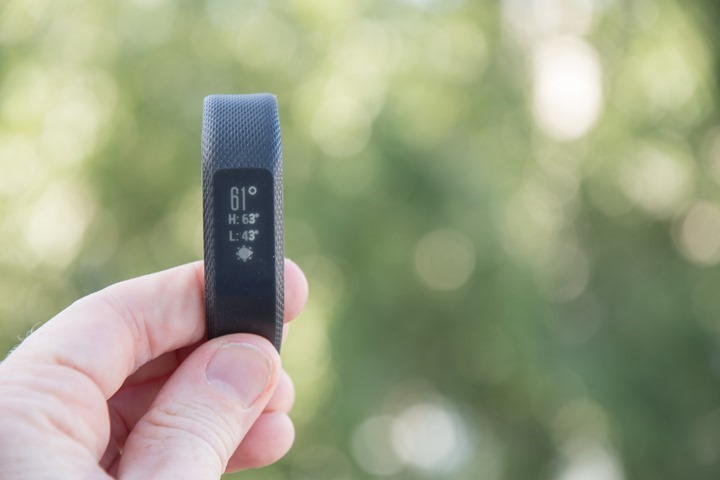
It’s interesting seeing Garmin take the Vivosmart series in a slightly different direction. By shrinking the display down and making it on-demand only, it’s going to appeal to a slightly different market than that of the Vivosmart HR (or even HR+). It’s basically going to appeal to the same market as the Fitbit Charge 2, which, is a pretty darned big market.
But that display cuts both ways. It is a heck of a lot brighter than before (like a lighthouse at night), which the previous model certainly can’t claim. And there’s no denying that this is brighter than anything Fitbit has in the smaller form factor level. Though clarity-wise in bright daylight, I’d say the Fitbit options are a tiny bit easier to read.
On the flipside, the new stress metrics on the Garmin itself, as well as the rep counting are advantages over the Fitbit Charge 2 or Alta HR. Fitbit has other things that can be seen as competitive (such as Connected GPS…aka…using your phone for GPS during a workout). I’m really surprised we haven’t seen Garmin offer this on their lower end devices. Perhaps it’s to protect those devices, but quite frankly it’s just not eating into sales there. Those folks carrying a phone can already do so for free. There’s a reason Fitbit offers it: To entice you into their platform and then eventually pitch you something else. Garmin continues to be horribly shortsighted from a business standpoint when it comes to the value of getting someone on Garmin Connect.
But as I often say – the best activity tracker for you is whichever activity tracker your friends are wearing. Being able to use social features within the app really only works if your friends are also users of the same platform (i.e. Fitbit or Garmin). And both Garmin and Fitbit make very solid activity trackers. You won’t go wrong with the Vivosmart 3, especially if you already have other Garmin devices or have friends who do.
With that – thanks for reading!
Found this review useful? Wanna support the site? Here’s how:

Hopefully you found this review useful. At the end of the day, I’m an athlete just like you looking for the most detail possible on a new purchase – so my review is written from the standpoint of how I used the device. The reviews generally take a lot of hours to put together, so it’s a fair bit of work (and labor of love). As you probably noticed by looking below, I also take time to answer all the questions posted in the comments – and there’s quite a bit of detail in there as well.
I’ve partnered with Clever Training to offer all DC Rainmaker readers exclusive benefits on all products purchased. By joining the Clever Training VIP Program, you will earn 10% points on this item and 10% off (instantly) on thousands of other fitness products and accessories. Points can be used on your very next purchase at Clever Training for anything site-wide. You can read more about the details here. By joining, you not only support the site (and all the work I do here) – but you also get to enjoy the significant partnership benefits that are just for DC Rainmaker readers. And, since this item is more than $75, you get free 3-day (or less) US shipping as well.
Garmin Vivosmart 3 (select dropdown for size)
Additionally, you can also use Amazon to purchase the unit (though, no discount). Or, anything else you pickup on Amazon helps support the site as well (socks, laundry detergent, cowbells). If you’re outside the US, I’ve got links to all of the major individual country Amazon stores on the sidebar towards the top.
Thanks for reading!

